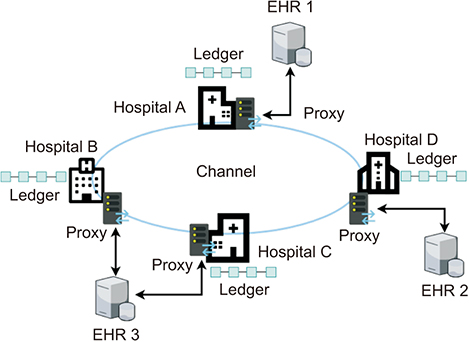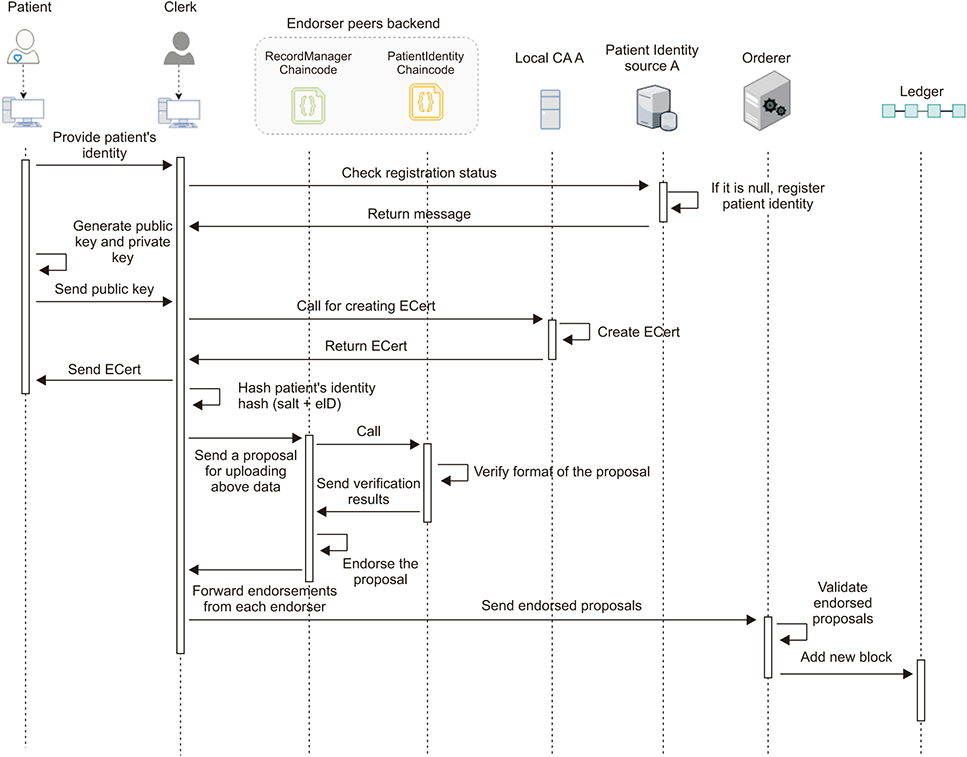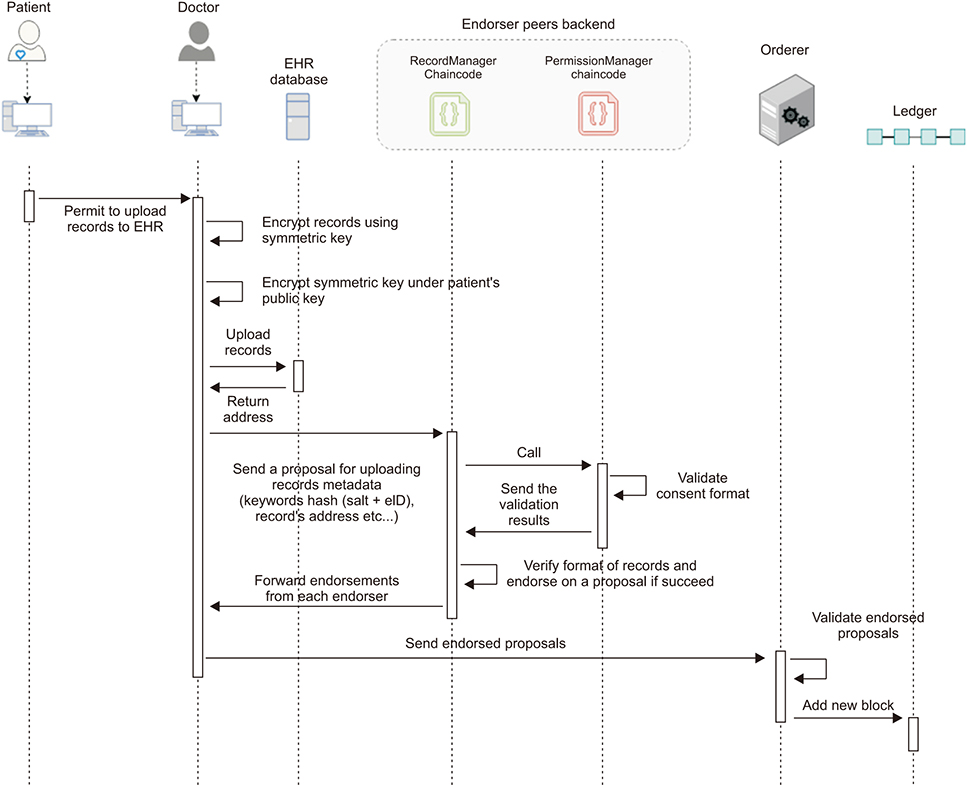Healthc Inform Res.
2020 Jan;26(1):3-12. 10.4258/hir.2020.26.1.3.
Application of Blockchain to Maintaining Patient Records in Electronic Health Record for Enhanced Privacy, Scalability, and Availability
- Affiliations
-
- 1Institute of Innovative Research, Tokyo Institute of Technology, Yokohama, Japan. j-lee@isl.titech.ac.jp
- KMID: 2469395
- DOI: http://doi.org/10.4258/hir.2020.26.1.3
Abstract
OBJECTIVES
Electronic Health Record (EHR) systems are increasingly used as an effective method to share patients' records among different hospitals. However, it is still a challenge to access scattered patient data through multiple EHRs. Our goal is to build a system to access patient records easily among EHRs without relying on a centralized supervisory system.
METHODS
We apply consortium blockchain to compose a distributed system using Hyperledger Fabric incorporating existent EHRs. Peer nodes hold the same ledger on which the address of a patient record in an EHR is written. Individual patients are identified by unique certificates issued by a local certificate authorities that collaborate with each other in a channel of the network. To protect a patient's privacy, we use a proxy re-encryption scheme when the data are transferred. We designed and implemented various chaincodes to handle business logic agreed by member organizations of the network.
RESULTS
We developed a prototype system to implement our concept and tested its performance including chaincode logic. The results demonstrated that our system can be used by doctors to find patient's records and verify patient's consent on access to the data. Patients also can seamlessly receive their past records from other hospitals. The access log is stored transparently and immutably in the ledger that is used for auditing purpose.
CONCLUSIONS
Our system is feasible and flexible with scalability and availability in adapting to existing EHRs for strengthening security and privacy in managing patient records. Our research is expected to provide an effective method to integrate dispersed patient records among medical institutions.
Keyword
MeSH Terms
Figure
Cited by 1 articles
-
Patient Consent Management by a Purpose-Based Consent Model for Electronic Health Record Based on Blockchain Technology
Dara Tith, Joong-Sun Lee, Hiroyuki Suzuki, W. M. A. B. Wijesundara, Naoko Taira, Takashi Obi, Nagaaki Ohyama
Healthc Inform Res. 2020;26(4):265-273. doi: 10.4258/hir.2020.26.4.265.
Reference
-
1. Greenhalgh T, Hinder S, Stramer K, Bratan T, Russell J. Adoption, non-adoption, and abandonment of a personal electronic health record: case study of HealthSpace. BMJ. 2010; 341:c5814.
Article2. Pylypchuk Y, Johnson C, Henry J, Ciricean D. Variation in Interoperability among US non-federal acute care hospitals in 2017. ONC Data Brief. 2018; (42):1–15.3. CommonWell Health Alliance. About CommonWell [Internet]. [place unknown]: CommonWell Health Alliance;c2020. cited at 2020 Jan 10. Available from: https://www.commonwellalliance.org/about/.4. CommonWell Health Alliance. Use cases and specifications [Internet]. [place unknown]: CommonWell Health Alliance;c2020. [cited at 2020 Jan 10]. Available from: https://www.commonwellalliance.org/connect-to-the-network/use-cases-and-specifications/.5. van der Linden H, Kalra D, Hasman A, Talmon J. Interorganizational future proof EHR systems: a review of the security and privacy related issues. Int J Med Inform. 2009; 78(3):141–160.6. Keris MP. A Pandora's Box: the EMR's audit trail [Internet]. [place unknown]: EMR Discovery Blog;2017. [cited at 2020 Jan 10]. Available from: https://www.emrdiscoveryintel.com/single-post/A-Pandoras-Box.7. Walsh T, Miaoulis W. Privacy and security audits of electronic health information. J AHIMA. 2014; 85(3):54–59.8. HIPAA compliance guide [Internet]. [place unknown]: The HIPAA Guide;c2017. [cited at 2020 Jan 10]. Available from: https://www.hipaaguide.net/hipaa-compliance-guide/.9. Xu X, Weber I, Staples M, Zhu L, Bosch J, Bass L, et al. A taxonomy of blockchain-based systems for architecture design. In : Proceedings of 2017 IEEE International Conference on Software Architecture (ICSA); 2017 Apr 3-7; Gothenburg, Sweden. p. 243–252.10. Sousa J, Bessani A, Vukolic M. A byzantine fault-tolerant ordering service for the hyperledger fabric blockchain platform. In : Proceedings of the 48th Annual IEEE/IFIP International Conference on Dependable Systems and Networks (DSN); 2018 Jun 25-28; Luxembourg City, Luxembourg. p. 51–58.11. Androulaki E, Barger A, Bortnikov V, Cachin C, Christidis K, De Caro A, et al. Hyperledger fabric: a distributed operating system for permissioned blockchains. In : Proceedings of the 13th EuroSys Conference; 2018 Apr 23-26; Porto, Portugal.12. Hyperledger Fabric. What is a blockchain [Internet]. [place unknown]: Hyperledger;c2019. [cited at 2020 Jan 10]. Available from: https://hyperledger-fabric.readthedocs.io/en/latest/blockchain.html.13. Dagher GG, Mohler J, Milojkovic M, Marella PB. Ancile: privacy-preserving framework for access control and interoperability of electronic health records using blockchain technology. Sustain Cities Soc. 2018; 39:283–297.
Article14. Roehrs A, da Costa CA, da Rosa Righi R. OmniPHR: a distributed architecture model to integrate personal health records. J Biomed Inform. 2017; 71:70–81.
Article15. Kuo TT, Kim HE, Ohno-Machado L. Blockchain distributed ledger technologies for biomedical and health care applications. J Am Med Inform Assoc. 2017; 24(6):1211–1220.
Article16. Manzoor A, Liyanage M, Braeke A, Kanhere SS, Ylianttila M. Blockchain based proxy re-encryption scheme for secure IoT data sharing. In : Proceedings of 2019 IEEE International Conference on Blockchain and Cryptocurrency (ICBC); 2019 May 14-17; Seoul, Korea. p. 99–103.17. Thakkar P, Nathan S, Viswanathan B. Performance benchmarking and optimizing hyperledger fabric blockchain platform. In : Proceedings of IEEE 26th International Symposium on Modeling, Analysis, and Simulation of Computer and Telecommunication Systems (MASCOTS); 2018 Sep 25-28; Milwaukee, WI. p. 264–276.18. Wang S, Ouyang L, Yuan Y, Ni X, Han X, Wang FY. Blockchain-enabled smart contracts: architecture, applications, and future trends. IEEE Trans Syst Man Cybern Syst. 2019; 49(11):2266–2277.
Article19. Preneel B. Cryptographic hash functions: theory and practice. In : Gong G, Gupta KC, editors. Progress in cryptology – INDOCRYPT 2010. Heidelberg, Germany: Springer;2010. p. 115–117.20. Thangam V, Chandrasekaran K. Elliptic curve based proxy re-encryption. In : Proceedings of the 2nd International Conference on Information and Communication Technology for Competitive Strategies (ICTCS); 2016 Mar 4-5; Udaipur, India. p. 1–6.21. Chow SS, Weng J, Yang Y, Deng RH. Efficient unidirectional proxy re-encryption. In : Bernstein DJ, Lange T, editors. Progress in cryptology – AFRICACRYPT 2010. Heidelberg, Germany: Springer;2010. p. 316–332.22. Ateniese G, Fu K, Green M, Hohenberger S. Improved proxy re-encryption schemes with applications to secure distributed storage. ACM Trans Inf Syst Secur. 2006; 9(1):1–30.
Article23. Azaria A, Ekblaw A, Vieira T, Lippman A. Medrec: using blockchain for medical data access and permission management. In : Proceedings of the 2nd International Conference on Open and Big Data (OBD); 2016 Aug 22-24; Vienna, Austria. p. 25–30.24. MedRec [Internet]. Cambridge (MA): MIT Media Lab;c2019. cited at 2020 Jan 10. Available from: https://medrec.media.mit.edu/technical/.25. Dubovitskaya A, Xu Z, Ryu S, Schumacher M, Wang F. Secure and trustable electronic medical records sharing using Blockchain. AMIA Annu Symp Proc. 2018; 2017:650–659.
- Full Text Links
- Actions
-
Cited
- CITED
-
- Close
- Share
- Similar articles
-
- Patient Consent Management by a Purpose-Based Consent Model for Electronic Health Record Based on Blockchain Technology
- A Study on Protecting Patients' Privacy of Obstetric and Gynecologic Nurses
- Blockchain Revolution in Healthcare : The Era of Patient-centered Dental Information System
- Survey on the Consumers' Attitudes towards Health Information Privacy
- Comparison of the Perception on Health Information Privacy Protection for Electronic Health Record among Patients, Healthcare Providers and Administration Groups






